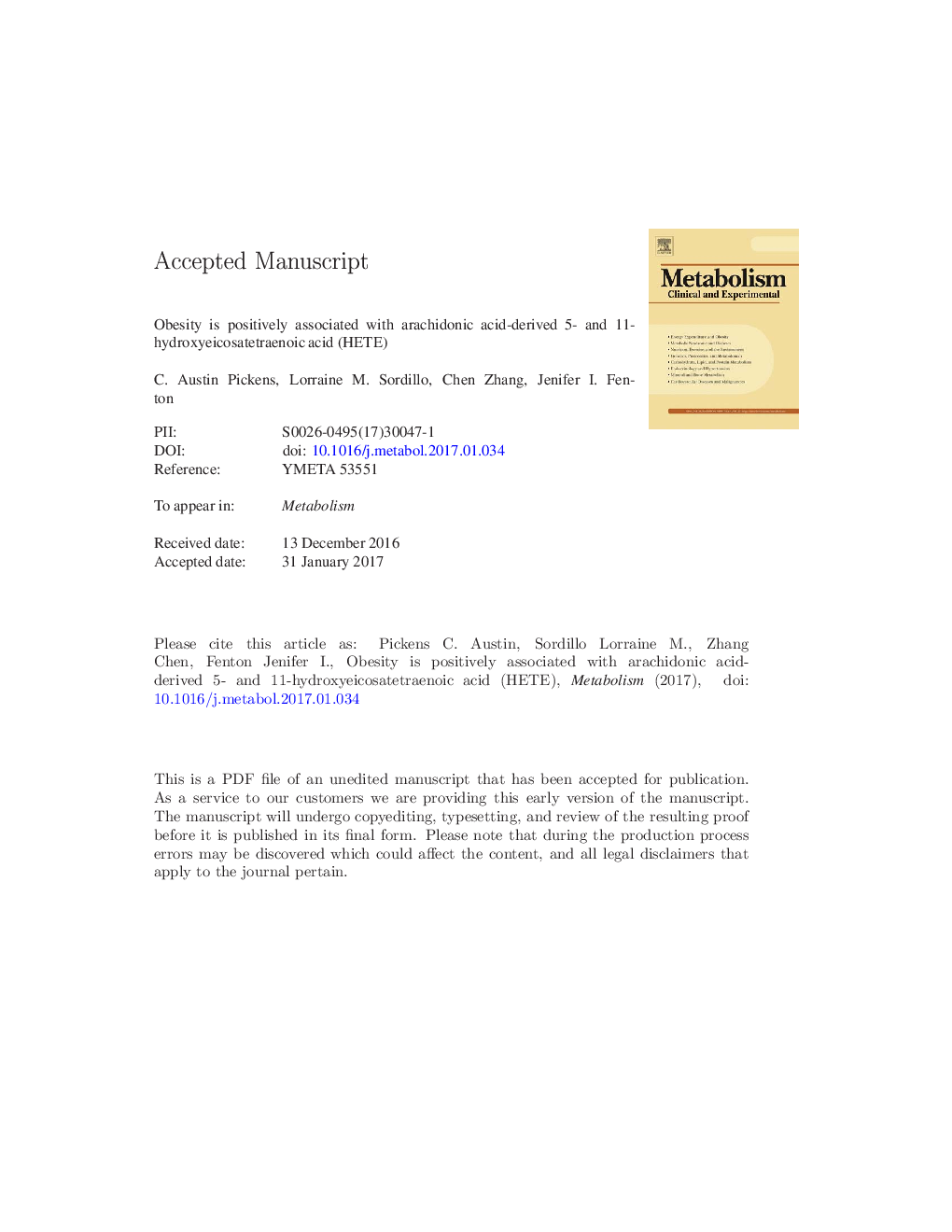| کد مقاله | کد نشریه | سال انتشار | مقاله انگلیسی | نسخه تمام متن |
|---|---|---|---|---|
| 5588402 | 1569039 | 2017 | 30 صفحه PDF | دانلود رایگان |
عنوان انگلیسی مقاله ISI
Obesity is positively associated with arachidonic acid-derived 5- and 11-hydroxyeicosatetraenoic acid (HETE)
دانلود مقاله + سفارش ترجمه
دانلود مقاله ISI انگلیسی
رایگان برای ایرانیان
کلمات کلیدی
CyPMRMALAPGE2HFDω-3LTB4DGLADiHETEHETrEhydroxyeicosatrienoic acidarachidonoyl ethanolamideepoxyoctadecenoic acidTbx2BHTAEAOxylipidsVicinal diolDHEACOXω-6HOTrEHDPAEPAdihydroxydocosapentaenoic acidDHET - dhetHODE - HEADMS/MS - MS / MSsEH - SEHcyclooxygenase - آنزیم سیکلواکسیژنازcytochrome P450 enzymes - آنزیم های سیتوکروم P450Arachidonic acid - اسید آراشیدونیکalpha-linolenic acid - اسید آلفا لینولنیکepoxyeicosatrienoic acid - اسید اپوکسی اسیاتریتروئینEicosapentaenoic acid - اسید ایکوزاپنتانوئیکdocosahexaenoic acid - اسید داکوزاگزوائونیکdihydroxyeicosatrienoic acid - اسید دی هیدروکسی اتیلنیکdihydroxyeicosatetraenoic acid - اسید دی هیدروکسی ایکواستاترونیکdihydroxyoctadecadienoic acid - اسید دی هیدروکسیکوکاتدادوئیکLinoleic acid - اسید لینولئیکhydroxyoctadecatrienoic acid - اسید هیدروکسیکوکاتدکاتریونیکhydroxyoctadecadienoic acid - اسید هیدروکسیکوکاتدکادویوئیکFatty acid - اسید چربPolyunsaturated fatty acid - اسید چرب غیر اشباعPUFA - اسید چرب چند غیراشباعOmega-3 - امگا 3omega-6 - امگا 6EpOME - اپومOxoode - اکسوودLOX - اکسیژن مایعthromboxane B2 - ترومبوکسی B2EET - خوردنARA - در حال حاضرWaist circumference - دور کمرDHA - دوکوساهگزائنوئیک اسیدdihomo-gamma-linolenic acid - دی هومو گاما لینولنیک اسیدDiHOME - دیهومhigh-fat diet - رژیم غذایی با چربی بالاbody mass index - شاخص توده بدنBMI - شاخص توده بدنیTandem mass spectrometry - طیف سنجی جرمی پشت سر هم یا متوالیLeukotriene B4 - لوکوترین B4lipoxygenase - لیپواکسیژنازObesity - مرض چاقیmultiple reaction monitoring - نظارت چندگانه چندگانهHETE - هفتهEpoxide hydrolase - هیدرولاز اپوکسیSoluble epoxide hydrolase - هیدرولاز اپوکسی سدیم حلالbutylated hydroxytoluene - هیدروکسی تورولین باتلاقیProstaglandin E2 - پروستاگلاندین E2high performance liquid chromatography - کروماتوگرافی مایع با کارایی بالاHPLC - کروماتوگرافی مایعی کارا
موضوعات مرتبط
علوم زیستی و بیوفناوری
بیوشیمی، ژنتیک و زیست شناسی مولکولی
علوم غدد
پیش نمایش صفحه اول مقاله

چکیده انگلیسی
We report that BMI, WC, and several serum cytokines were highly associated arachidonic acid (ARA)-derived hydroxyeicosatetraenoic acids (HETEs), and vicinal diols (i.e., alcohols on adjacent carbon atoms) derived from several PUFAs. There was a significant linear relationship between BMI, WC, and serum leptin, and ARA-derived 5-, 11-, and 15-HETE. Specifically, BMI and WC were positively associated with proinflammatory 5- and 11-hydroxyeicosatetraenoic acid (HETE), even after normalization to ARA concentrations and false discovery p-value correction. Individuals with 5-HETE concentrations > 5.01 nmol/L or 11-HETE concentrations and > 0.89 nmol/L were over 5 times more likely to be obese compared to those with â¤Â 1.86 nmol/L and â¤Â 0.39 nmol/L, respectively. Vicinal diols from linoleic, eicosapentaenoic, and docosahexaenoic acid were inversely associated with obesity. Across all statistical tests, vicinal diols were inversely associated with obesity whether normalized to parent PUFA concentrations or normalized to precursor epoxides. Interestingly, the proinflammatory cytokines IL-6 and TNF-α were not associated with any oxylipids. Since 5-HETE is a 5LOX product, 11-HETE is marker of lipid peroxidation, and vicinal diols are formed through soluble epoxide hydrolase (sEH) metabolism of CYP epoxygenated PUFAs, therefore, these results indicate that obesity is likely associated with altered metabolism with distinct oxygenating pathways. Taken together, our results indicate that obesity is associated with specific oxylipids indicative of altered PUFA metabolism through several pathways (i.e., LOX, reactive oxygen species, and sEH and CYP epoxygenase), rather than attributed solely to altered dietary PUFA intake.
ناشر
Database: Elsevier - ScienceDirect (ساینس دایرکت)
Journal: Metabolism - Volume 70, May 2017, Pages 177-191
Journal: Metabolism - Volume 70, May 2017, Pages 177-191
نویسندگان
Charles Austin Pickens, Lorraine M. Sordillo, Chen Zhang, Jenifer I. Fenton,